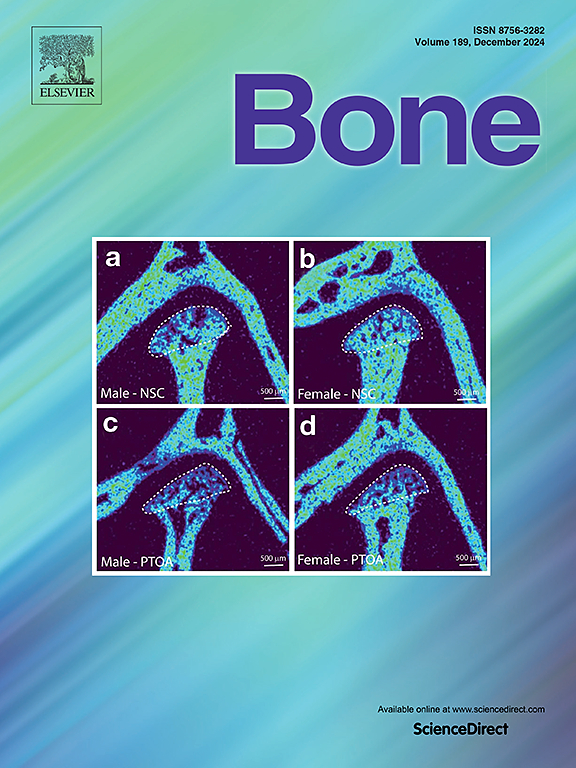利格列汀-二甲双胍联合:一种减轻4-乙烯基环己烯二环氧化物和地塞米松诱导的小鼠骨质疏松症的新方法。
IF 3.6
2区 医学
Q2 ENDOCRINOLOGY & METABOLISM
引用次数: 0
摘要
二肽基肽酶(DPP-4)水平升高与骨吸收加速有关,与绝经后骨质疏松症(PMO)和糖皮质激素诱导的骨质疏松症(GIO)有关。因此,DPP-4抑制剂,一类抗糖尿病药物,作为潜在的候选药物被重新用作抗骨质疏松剂。在本研究中,我们探讨了利格列汀(一种DPP-4抑制剂)治疗4周及其联合二甲双胍对小鼠PMO和GIO的影响。Balb/c小鼠经注射4-乙烯基二氧化环己烯(VCD), 160 mg/kg, ip诱导PMO,持续15 天;地塞米松(DEX), 5 mg/kg, ip诱导GIO,持续21 天。利格列汀-二甲双胍联合用药后,观察到骨结构参数和骨密度(BMD)有显著改善,这与骨转换标志物的改变一致,即ALP、骨钙素、BMP-2升高,血清钙、TRAP、硬化蛋白和促炎细胞因子降低。骨免疫组化(IHC)结果显示,联合用药导致免疫阳性OPG细胞增加,RANKL表达减少。然而,利格列汀在PMO模型中仅显示出部分改善。相反,在GIO模型中,利格列汀除了改善BMD和硬化蛋白水平外,没有表现出显著的效果。二甲双胍治疗对两种模型均无显著影响。这些发现提示利格列汀联合二甲双胍可能通过靶向AMPK和Wnt信号通路,从而调节BMP-2、sclerostin和RANKL/OPG来缓解PMO和GIO。本文章由计算机程序翻译,如有差异,请以英文原文为准。

Linagliptin-metformin combination: A novel approach to mitigate 4-vinyl cyclohexene di epoxide and dexamethasone-induced osteoporosis in mice
Elevated levels of dipeptidyl-peptidase (DPP-4) enzyme, associated with accelerated bone resorption, are linked to both post-menopausal osteoporosis (PMO) and glucocorticoid-induced osteoporosis (GIO). Consequently, DPP-4 inhibitors, a class of anti-diabetic drugs, emerge as potential candidates for repurposing as anti-osteoporotic agents. In this study, we explored the effect of 4-week treatment with linagliptin (a DPP-4 inhibitor) and its combination with metformin on PMO and GIO in mice. PMO was induced in Balb/c mice by injecting 4-vinyl cyclohexene diepoxide (VCD), 160 mg/kg, ip for 15 days while GIO was induced by administering dexamethasone (DEX) 5 mg/kg, ip for 21 days. A significant improvement in bone architectural parameters and bone mineral density (BMD) was observed following the linagliptin-metformin combination, which was consistent with the altered bone turnover markers i.e., increased ALP, osteocalcin, BMP-2, and reduced serum calcium, TRAP, sclerostin and pro-inflammatory cytokines. Results from bone immunohistochemistry (IHC) demonstrated that the combination led to an increase in immunopositive OPG cells, while RANKL expression was diminished. Linagliptin, however, demonstrated only partial improvement in the PMO model. Conversely, in the GIO model, linagliptin did not show a significant effect except for improved BMD and sclerostin levels. Treatment with metformin did not show significant changes in either model. These findings suggest that the combination of linagliptin with metformin could alleviate the PMO and GIO, possibly through targeting AMPK and Wnt signaling pathway and thereby modulating BMP-2, sclerostin and RANKL/OPG.
求助全文
通过发布文献求助,成功后即可免费获取论文全文。
去求助
来源期刊

Bone
医学-内分泌学与代谢
CiteScore
8.90
自引率
4.90%
发文量
264
审稿时长
30 days
期刊介绍:
BONE is an interdisciplinary forum for the rapid publication of original articles and reviews on basic, translational, and clinical aspects of bone and mineral metabolism. The Journal also encourages submissions related to interactions of bone with other organ systems, including cartilage, endocrine, muscle, fat, neural, vascular, gastrointestinal, hematopoietic, and immune systems. Particular attention is placed on the application of experimental studies to clinical practice.
 求助内容:
求助内容: 应助结果提醒方式:
应助结果提醒方式:


